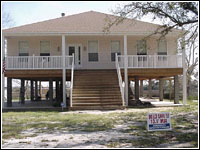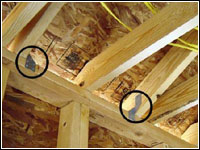Tips For Reducing Future Flood Damage
Elevate Your Home
 One of the most common retrofitting methods is elevating a house to a required or desired Flood Protection Elevation (FPE). When a house is properly elevated, the living area will be above all but the most severe floods (such as the 500 year flood). Communities may apply to the Hazard Mitigation Grant Program for funding for elevation projects.
One of the most common retrofitting methods is elevating a house to a required or desired Flood Protection Elevation (FPE). When a house is properly elevated, the living area will be above all but the most severe floods (such as the 500 year flood). Communities may apply to the Hazard Mitigation Grant Program for funding for elevation projects.
In addition to a greater peace of mind, advantages to elevating include the following:
- Elevation to or above the Base Flood Elevation (BFE) allows a substantially damaged or substantially improved house to be brought into compliance with your community's floodplain management ordinance or law. (The Base Flood is a flood having a 1% chance of being equaled or exceeded in any given year)
- Elevation reduces the flood risk to the house and its contents.
- Except where a lower floor is used for storage, elevation eliminates the need to move vulnerable contents to areas above the water level during flooding.
- Elevation techniques are well known, and qualified contractors are often readily available.
- Elevation reduces the physical, financial, and emotional strain that accompanies floods.
- Elevation provides homeowners with additional parking and storage space within their home.
- Elevation often reduces flood insurance premiums.
Inexpensive Changes Can Reduce Damage
Following are some simple, inexpensive steps you can take to protect your property from future flood damage.
- Raise the electrical box at least 12 inches above the base flood elevation or relocate the box to an upper floor. (Ask your local building official what the base flood elevation is for your area.)
- Elevate the water heater and heating system on a masonry base at least 12 inches above the base flood elevation or relocate them to an upper floor.
- Elevate the washer and dryer on masonry or pressure-treated lumber at least 12 inches above the projected flood elevation. Other options are moving the washer and dryer to a higher floor, or building a floodwall around the appliances.
- Anchor the fuel tank to the floor or wall to prevent it from overturning or floating away. Metal structural supports and fasteners must be non-corrosive. Wooden supports must be pressure treated.
- Install a floating floor-drain plug at the lowest point of the lowest finished floor. When the floor drainpipe backs up, the float rises and plugs the drain.
- Install a backflow valve to prevent sewer backup from coming into your home.
Business owners can also protect their property to reduce future disaster damages by installing a generator for emergency power, protect business records and inventory computer files, and prepare an emergency plan.
How To Rebuild A More Wind-Resistant Home
 If you're rebuilding your home, consider this: If the roof is not properly built or tied down, any upsurge of wind blowing into the home through broken windows and doors puts enormous press on the underside of a roof. It can destroy your roof and cause even greater interior damage. That's why FEMA mitigation experts say that the rebuilding process is a good time to incorporate some features that could make your house more resistant to hurricane force winds in the future.
If you're rebuilding your home, consider this: If the roof is not properly built or tied down, any upsurge of wind blowing into the home through broken windows and doors puts enormous press on the underside of a roof. It can destroy your roof and cause even greater interior damage. That's why FEMA mitigation experts say that the rebuilding process is a good time to incorporate some features that could make your house more resistant to hurricane force winds in the future.
Some of this mitigation work can be done by competent homeowners, while other recommended steps probably require professional contractors, according to FEMA's mitigation specialists. Safety is always the first concern if there are any changes to electrical wiring.
Mitigation specialists caution that you should talk with local building officials before you begin. They can provide useful information on local standards and building codes.
Some suggestions to consider:
- Install high wind connectors: These connectors are either galvanized steel or stainless steel (a coastal area consideration). The "continuous load path" method of tying down a home's roof to its foundation is an effective means of resisting damage to structures subjected to high winds. Connectors engage roof rafters, attic joists and supporting stud walls, creating a stronger unit. Connectors also engage intermediate floors to the stud walls, above and below each level. Finally, connectors tie together the bottom stud wall and bottom plate to the foundation.
High wind connectors may be difficult for homeowners to install, so you may want a professional to do the work. Also, you may want to check with your local government's building officials to see if your community has special permits or requirements.
- Install storm shutters: Storm shutters can be secured over windows, skylights and other glass-covered openings, helping your home withstand hurricane force winds as well as providing safeguards against flying glass. Pre-manufactured storm shutters are also available; however, it is not difficult to make your own. For more information on shutters, contact your local building supply retailer. If you install pre-made shutters, be sure to follow the manufacturer's instructions carefully. Again, check with local officials about any permit requirements.
- Check your doublewide garage doors: Doublewide (two-car) garage doors can wobble, pull off their tracks and collapse in especially high winds. Check with your local government's building officials and ask about any code requirements for garage doors. Single framing on each garage doorway is recommended, if you are rebuilding or want to retrofit a multi-vehicle garage. Retrofit kits are also available. Check with your local building supply retailer. Also, check the ceiling track on your garage door and make sure that it is either anchored to the 2x4s inside the wall with heavy wood bolts, or properly attached to masonry with expansion bolts.
- Brace end walls on gable-roofed houses: Homes with gabled roofs are more likely to suffer damage during a hurricane. A gabled roof looks like an "A" from each end of the house - with outside walls that end under the roofline. The end walls of gable-roofed homes can be heavily stressed in high-wind conditions and, if they're not properly braced, may collapse or cause greater damage. If you own a trussed gable-roofed home and the roof trusses are not properly braced, the addition of truss bracing can allow it to withstand hurricane-force winds. Truss bracing usually consists of 2x4s that run the length of the roof.
It is also a good idea to brace the gable ends of your home. Gable-end bracing consists of two 2x4s placed in an "X" pattern. One 2x4 runs from the ridge of the gable end to the bottom center of the fourth truss from the end of the house. The other 2x4 runs from the bottom center of the gable to the ridge of the fourth truss.
- Find out more about flood risks and flood insurance at www.floodsmart.gov.
Last Modified: Tuesday, 17-Jul-2007 11:02:37 EDT
